城市地表灰尘指分散在城市地表粒径小于20目的固体颗粒物, 它是一种特殊的环境介质, 组成较复杂, 包括工业生产排放的烟尘、汽车尾气和土壤等[1].城市地表灰尘在环境系统中是一种重要的污染物质载体[2], 除了能够反映一些环境信息外, 还可以指示区域环境质量的好坏.重金属污染物由于自身的持久性和难降解性, 被看作“化学定时炸弹”[3].受到城市建设、工业生产和交通运输等人类活动的强烈影响, 城市地表灰尘中常常累积了大量有毒有害的重金属污染物[4].携带重金属等污染物的灰尘受到外力(如风力)影响, 会在大气中反复地扬起-沉降-扬起[5], 影响大气环境质量.另外, 地表灰尘会通过皮肤接触、呼吸和摄入等途径进入人体, 而其中的污染物会危害人的健康.
鉴于灰尘的环境影响及危害, 近年来国内外学者[6~10]对不同地区地表灰尘中重金属的含量、污染水平、分布特征、健康风险等展开了大量的研究.目前已有关于校园地表灰尘的研究多集中于幼儿园、小学以及中学[11~14], 对于高校灰尘重金属污染研究较少[15~17].相比于幼儿园和中小学, 高校内人口更加密集且活动更加频繁.本课题组之前对西安市中小学校园灰尘中重金属污染开展了一定的研究工作[18~21], 但主要是评价中小学校园灰尘重金属健康风险, 对其来源研究甚少.西安市高校众多, 但关于西安高校校园灰尘重金属研究未见报道.本研究在课题组前期工作的基础上对其进行补充, 进一步对西安市大学校园灰尘中重金属的含量、累积特征及来源进行探讨, 以期为大学校园环境保护及师生健康防护提供科学依据.
1 材料与方法 1.1 研究区概况及样品收集与预处理西安(107°40′~109°49′ E, 33°39′~34°45′ N)位于关中盆地中部, 东以零河和灞源山地为界, 西以太白山地及青化黄土台塬为界, 南邻秦岭, 北临渭河和黄土高原, 面积达9 983 km2, 其中市区面积1 066 km2.西安市气候为暖温带半湿润大陆性季风气候, 冷暖干湿四季分明.年平均气温13~14℃, 年降水量522.4~719.5 mm.西安是中国重要的教育和科研基地, 根据西安市统计局(http://tjj.xa.gov.cn/)数据显示, 截至2018年全市普通高等学校共63所, 本科院校42所, 专科院校21所, 在校学生数共71.3万人.本文所选的高校中, 除西安美术学院、西安音乐学院、西安体育学院三所专业特色类高校人数为1万人左右, 其余高校人数均超过2万余人且大多数高校分布在西安市三环以内.
采集西安市25所高校的35个校园灰尘样品, 各采样点如图 1所示.2018年12月在连续一周以上没有降雨的情况下对西安市高校地表灰尘进行采样, 用干净的塑料板和毛刷清扫各高校楼梯、窗台、操场等学生活动过程中可能接触的室外场所灰尘样品, 经多方位采集后将其混合为重约200~300 g的样品, 装入聚乙烯自封袋中.在实验室内, 将采集的样品摊开, 除去其中大石头、树枝等杂物, 然后于室温且通风、避光的条件下风干2~3周至恒重后过0.9 mm尼龙筛, 保存.
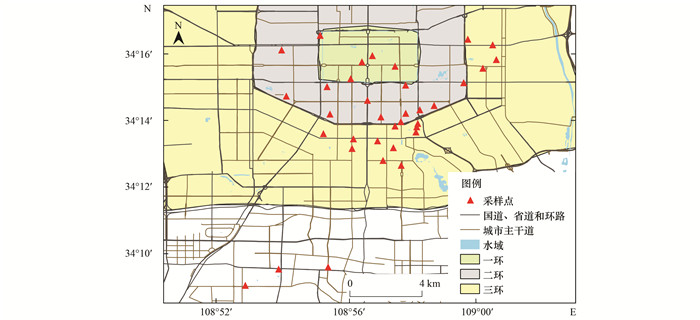
|
图 1 西安市高校灰尘采样点示意 Fig. 1 Location of dust sampling sites in Xi'an City universities |
将过0.9 mm尼龙筛的样品通过振动磨(长春光学精密机械与物理研究所, JJY-60型)研磨10 s使其粒径小于0.075 mm, 称取4.5 g样品, 使用半自动压样机(长春光学精密机械与物理研究所, ZM-1型)于30 t压力下将样品压制成圆形片状待测样品.用X-Ray荧光光谱仪(XRF, 德国布鲁克, S8型)测出样品中Mn、Co、Cu、Pb、Cr、Zn、Ni、As和V的含量, 同时使用GSS8标准样品与重复样进行质量控制, 分析元素的误差均控制在5%以内.运用开源软件R 3.6.0和SPSS 25.0对测定数据进行统计与分析.
1.3 重金属富集因子富集因子法不仅能够评价样品中重金属元素的富集水平, 还能揭示重金属所受人为活动的影响, 从而粗略判断重金属的污染来源[22].公式如下:

|
(1) |
式中, Ci/Cn是实测重金属元素i与参比元素n含量的比值, S和B分别表示样品与背景.本文中选择Al(Al2O3, 变异系数为0.05)为参比元素, 取其测得数据平均值为参比元素的背景值, 各重金属元素背景值参考陕西省表层土壤背景值: Mn为557.0 mg·kg-1、Cr为62.5 mg·kg-1、Cu为21.4 mg·kg-1、Ni为28.8 mg·kg-1、As为11.1 mg·kg-1、Co为10.6 mg·kg-1、Zn为69.4 mg·kg-1、V为66.9 mg·kg-1和Pb为21.4 mg·kg-1[23].富集因子分级参考文献[24].
1.4 异常数据分析异常数据也称离群值、异常值或特异值, 指某个样本里的小部分数据与该样本的其他数据偏离严重.异常数据在环境地球化学数据集中经常被观测到, 可能是由自然和人为因素造成的.一方面, 在自然条件下可能存在矿化现象, 产生一些异常值.另一方面, 环境污染也会导致异常值, 有时人为处理样品过程中也会产生异常值[25], 所以有必要对数据集进行异常数据识别.本研究采用极差法(平均值±3倍标准偏差)对所测重金属含量中异常值进行识别[26], 结果显示:V和Mn(西安医学院), Pb(西安电子科技大学北校区)、As(长安大学雁塔校区)、Zn(西安交通大学雁塔校区)和Cu(西安美术学院和西北政法大学长安校区)为异常值.但由于这些异常值都是客观存在的, 不能直接随便删除[25].本文采用正常值的最大、最小值对异常值进行替换[27].
2 结果与讨论 2.1 重金属含量特征西安市高校校园地表灰尘中重金属含量如表 1, 重金属Mn、As、Pb、Cr、Co、Ni、Cu、V和Zn的平均含量分别为595.1、13.8、158.6、145.1、13.2、35.8、93.5、70.9和665.9 mg·kg-1, 均超过陕西省表层土壤元素背景值[23].Pb和Zn的平均含量分别为其土壤背景值的7.4倍和9.6倍, 明显比其他元素高.变异系数(CV)的大小在一定程度上能够反映重金属元素含量所受人为活动影响的强弱[28].CV越大, 说明重金属元素含量在空间尺度的变化和人为干扰的影响越大.Wilding[29]将其分为高度变异(CV≥36%)、中等变异(16% ≤CV < 36%)和低度变异(CV < 16%)这3级.本研究中各重金属变异系数从大到小排列顺序为:Zn>Pb>Cu>As>Cr>Ni>Co>Mn>V, 其中Zn、Pb和Cu属高度变异, 可能是由于人为干扰较强烈; As、Cr、Ni、Co和Mn次之, 属中等变异; V属低度变异.
|
|
表 1 西安市高校地表灰尘重金属含量/mg·kg-1 Table 1 Heavy metal content of surface dust in Xi'an City universities/mg·kg-1 |
图 2将西安市高校校园灰尘中重金属同西安市幼儿园和小学校园灰尘中重金属的含量[20]做对比, 发现高校校园灰尘重金属中除Cr、Pb和Co的含量略低于幼儿园和小学校园灰尘外, Mn、V、As、Ni、Cu和Zn含量均高于幼儿园和小学灰尘, 这可能是由于高校相对于幼儿园和小学比较开放, 来自外界的干扰较多, 并且高校人群基本都是成年人而幼儿园和小学里都是儿童, 所以高校校园在卫生清洁方面没有幼儿园和小学校园到位, 因此高校校园灰尘中多数重金属含量较高.
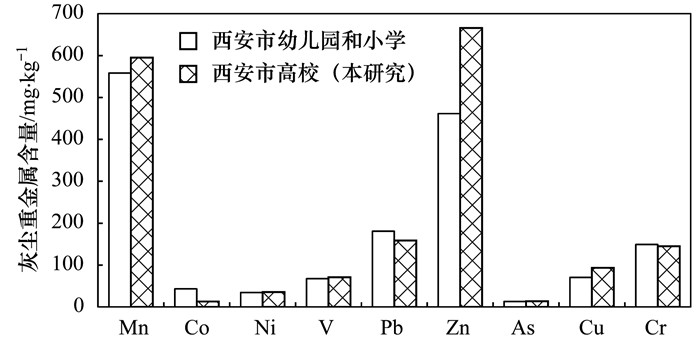
|
图 2 西安市高校校园与幼儿园和小学重金属含量对比 Fig. 2 Comparison of heavy metal content between universities, kindergartens, and primary schools in Xi'an City |
9种元素Mn、As、Pb、Cr、Co、Ni、Cu、V和Zn的富集因子(EF)变化范围分别是:0.6~1.5、0.5~2.4、2.6~26.9、1.1~4.3、0.8~1.9、0.7~1.9、1.9~10.5、0.7~1.2和2.6~52.2, 平均值排序: Zn(9.7)>Pb(7.5)>Cu(4.4)>Cr(2.3)>As(1.2)=Co(1.2)=Ni(1.2)>Mn(1.1)=V(1.1), 均呈现出不同的富集程度.某重金属富集因子的值越大, 则表示受到的人为干扰影响越大.Zn、Pb元素EF的最大值分别是最小值19.8、10.4倍, 说明个别点位受到的人为干扰十分强烈.Aristomenis等[24]认为EF≤2时为无富集或是轻微富集; 2~5时为中度富集; 5~20时为显著富集.从图 3中可看到Mn、Co、Ni、As和V的EF<2, 说明这5种元素整体富集程度低, 受到的人为干扰很小; Cr和Cu属中度富集, 受到一定的人类活动影响; Pb和Zn则呈显著富集, 表明强烈的人类活动对这两种元素的富集起到了主要作用.
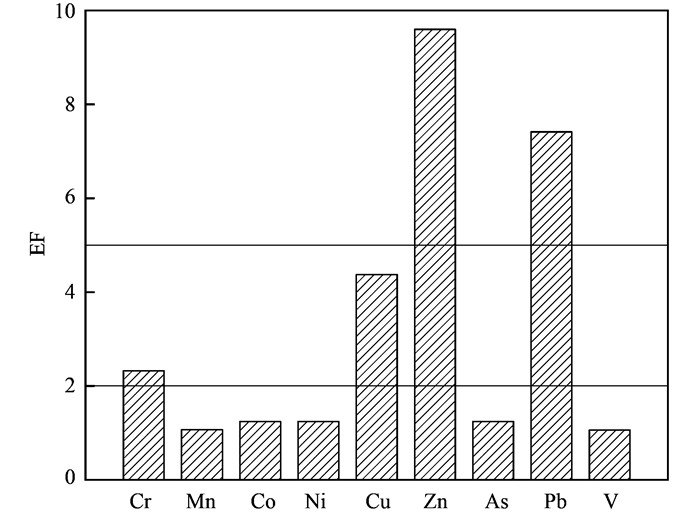
|
图 3 重金属EF平均值 Fig. 3 Heavy metal EF average |
为了避免所测重金属含量异常值对多元统计方法结果的影响, 使用替换后的数据进行分析.将数据导入R软件, 得出西安市高校地表灰尘中9种重金属相关矩阵图 4, 发现重金属之间表现出了明显的相关关系.除Co-As(r=0.38, P=0.026)外, V-Mn-Ni-As-Co两两之间在P < 0.01水平都显著正相关, 表明其具有相似的来源; Zn和Pb在P < 0.05水平上两者之间的相关系数(0.41)相对其他重金属最大, 且Cr除了与Zn、Pb有弱正相关外, 与其他元素都呈负相关, 暗示这三者来源可能相似, 也可能Cr有单独来源; Cu与其他8种元素之间均无相关性, 推断其可能具有单独的来源.
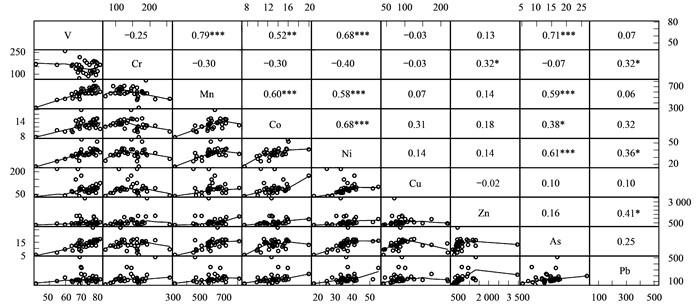
|
对角线为各重金属元素名称; 右上三角中数字表示重金属之间的相关系数, ***表示P < 0.001, **表示P < 0.01, *表示P < 0.05; 左下三角为具有拟合线的双变量散点图, 图框外数字表示对应重金属元素含量(mg·kg-1) 图 4 西安高校地表灰尘重金属相关矩阵 Fig. 4 Correlations matrix for dust heavy metal concentrations in Xi'an City universities |
基于Ward欧氏距离法对9种重金属35个校园灰尘数据进行系统聚类分析, 以35个校园样品为Y轴, 9种重金属为X轴绘制图 5.其中每个颜色的小矩形代表一个样品中一种重金属的含量, 颜色由白到红表示重金属的含量由高到低.由X轴可看出, 9种重金属共分为3组, V-As-Co-Ni-Mn属一组, 表明这5种重金属具有同源性; Zn-Pb-Cr为一组; Cu被单独分为一组, 可能是Cu与其余重金属具有不同的来源.从Y轴方向来看, 35个点位被分为两大组.第一组共24个点位, 占总点位的68.6%, 颜色整体偏白; 第二组占总点位的31.4%, 颜色偏红, 反映出第一组的污染情况比第二组重.并且发现第一组的样点绝大多位于道路复杂、交通繁忙、人口密集的位置, 而第二组的样点情况与第一组正好相反, 说明人类活动对重金属有累积效应.
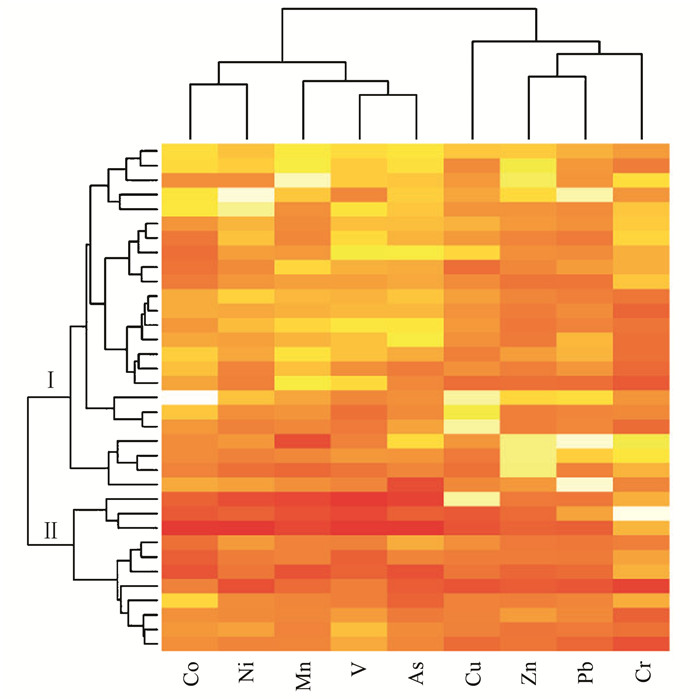
|
图 5 地表灰尘中9种重金属系统聚类谱系 Fig. 5 Clustering tree of hierarchical cluster analysis of nine heavy metals in surface dust |
对重金属含量数据进行检验(KMO=0.668>0.5, Bartlett=0.000), 可以使用因子分析.经凯撒正态化最大方差法旋转后, 从9个变量中提取出3个特征值大于1的因子, 累计占方差的75.991%.旋转载荷结果见表 2.第一主成分(PC1)载荷较高的因子有V(0.943)、Mn(0.845)、As(0.843)、Ni(0.737)和Co(0.861), 解释了总方差的37.413%.第二主成分(PC2)主要由Cr(0.769)、Zn(0.771)和Pb(0.742)加权, 解释了总方差的21.075%.第三主成分(PC3)中Cu(0.862)的载荷最高, 占总方差的17.503%.
|
|
表 2 西安市高校地表灰尘重金属主成分分析1) Table 2 Principal component analysis of heavy metals in surface dust in Xi'an City universities |
2.2.5 重金属来源解析
富集因子法粗略判断出As、V、Mn、Ni和Co这5种元素基本未受到人类活动的影响, 属于自然富集, 而Cr、Cu、Pb和Zn的EF值较大则受到人为干扰较强, 是人类生活生产过程中造成污染使其富集.结合相关分析、聚类分析和主成分分析结果, 将西安市高校地表灰尘中9种重金属元素分为3组.第一组为V、Mn、As、Ni和Co, 彼此之间呈现显著正相关, 聚类被归为一类.土壤中Al2O3和Fe2O3可以代表主要成岩元素的天然地球化学联系, 反映母岩的天然来源[30], 将这5种元素与两种地壳标识性指标进行相关性分析, 结果见表 3, 发现二者与V、Mn、As、Ni和Co均有显著相关性, 认为他们具有相似的地球化学行为, 这可能与当地的母质有关.重金属Mn通常被当作自然源的特征元素[31], 也常被当作参照元素来判断人为原因对重金属累积影响.图 4中Mn与V、As、Ni、Co都呈极显著相关, 此外该5种元素含量平均值与陕西省表层土壤背景值相当, 且变异系数也较小, 说明人为干扰对这几种元素的影响较小.常玉玉等[20]在对西安市小学及幼儿园灰尘重金属分布发现, As、Mn、Ni和V的含量和陕西省表层土壤背景值相差不大, 认为其来源为自然源; 石栋奇等[32]在分析西安市道路细颗粒灰尘中重金属来源时, 将Co、Ni、Mn和V这4种元素来源判定为自然源(当地土壤).综上, 这5种元素累积主要是由于自然因素导致, 即第一组元素代表自然源.
|
|
表 3 研究元素与地壳标识性指标间的Pearson相关系数1) Table 3 Pearson correlation coefficients between the studied elements and crustal identification indicators |
第二组元素是Cr、Zn和Pb.在相关性分析中无法确定Cr与Zn、Pb的关系, 但在聚类与主成分分析结果中显示三者应属一类.Zn-Pb元素组合被看作是交通污染的特征[33], Zhao等[34]认为汽车尾气会排放铅Pb.虽然现在禁止使用含铅汽油, 但由于以前使用含铅汽油从而导致大量Pb沉降在地表, 当扬尘飞起时Pb进入大气, 吸附于灰尘表面[35].Shi等[36]的研究也发现上海市的街道灰尘中Pb和Cr主要源于交通污染, 风化腐蚀以及建筑施工的建材.本研究中Pb含量高的校园周边工业活动少, 交通繁忙, 因此Pb的累积主要受到交通活动的影响.轮胎硬化剂材料中含有Zn, 其与地面摩擦是Zn产生的重要途径.Chen等[37]认为锌与汽车轮胎的磨损和镀锌汽车零部件的腐蚀有关.本文中Zn的高值点西安电子科技大学北校区、西安交通大学雁塔校区和西安财经大学雁塔校区主要分布在大医院周围、旅游景点人口密集处以及毗邻地铁的位置, 这些地方交通密集车流量大.Cr广泛用于生产铝合金、钛合金、不锈钢及汽车零部件, 随时间的累积, 车辆机械部件的不断磨损导致Cr向周围排放[38].Johansson等[39]的研究发现Cr也是汽车尾气排放的重要组成部分.本研究区域内Cr与Zn、Pb高值分布类似, 所以判断这3种元素来源于交通运输.
第三组元素只有Cu.有研究证实Cu来源于汽车金属的腐蚀[40]、刹车线的材料, 润滑油的添加剂及防腐蚀、防氧化材料等[1], 经调查发现在高值点西安工程大学周围有卡尔汽车服务、博航汽车维修和泽豪汽车装潢等汽修服务商铺, 高值点西安理工大学高等技术学院附近有玉林汽配城、驰加轮胎汽车装潢和瓦尔塔蓄电池专卖店等汽车零部件售卖店.另外西安美术学院也是Cu的一个高值点, 有研究表明Cu不仅来源于金属磨损、电镀金属的腐蚀, 还来源于油漆涂料[41], 所以西安美术学院周围Cu含量高可能是由于学生较为频繁地使用油漆, 颜料等.因此Cu的来源属于混合源, 其中一部分源自汽修行业, 另一部分则来自油漆染料.
3 结论(1) 西安市各高校地表灰尘中所研究9种元素含量的平均值均超过陕西省表层土壤背景值, 其中Zn、Pb和Cu分别高达背景值的9.6、7.4和4.4倍.
(2) 富集因子结果显示V、Mn、Co、As和Ni这5种重金属元素富集程度低, 人为干扰对其富集影响小; Cr和Cu中度富集; Zn和Pb显著富集, 受到强烈的人类活动影响.多元统计分析表明:V、Mn、As、Ni和Co的累积主要来源于自然, 由成土母质等自然因素控制; Cr、Zn和Pb主要来自交通源, Cu则主要来自汽修行业与油漆染料.
| [1] | Hou S N, Zheng N, Tang L, et al. Pollution characteristics, sources, and health risk assessment of human exposure to Cu, Zn, Cd and Pb pollution in urban street dust across China between 2009 and 2018[J]. Environment International, 2019, 128: 430-437. |
| [2] | Zhang J, Li R F, Zhang X Y, et al. Traffic contribution to polycyclic aromatic hydrocarbons in road dust:a source apportionment analysis under different antecedent dry-weather periods[J]. Science of the Total Environment, 2019, 658: 996-1005. |
| [3] |
郑小康, 李春晖, 黄国和, 等. 保定城区地表灰尘污染物分布特征及健康风险评价[J]. 环境科学学报, 2009, 29(10): 2195-2202. Zheng X K, Li C H, Huang G H, et al. Pollutant distribution in urban dusts of Baoding and health risk assessment[J]. Acta Scientiae Circumstantiae, 2009, 29(10): 2195-2202. |
| [4] | Pan H Y, Lu X W, Lei K. A comprehensive analysis of heavy metals in urban road dust of Xi'an, China:contamination, source apportionment and spatial distribution[J]. Science of the Total Environment, 2017, 609: 1361-1369. |
| [5] |
李小平, 张蒙, 周骞, 等. 乌鲁木齐城市土壤与灰尘粒径空间分布特征[J]. 中国环境监测, 2019, 35(1): 37-43. Li X P, Zhang M, Zhou Q, et al. Spatial distribution of particle size of urban soil and dust in Urumqi[J]. Environmental Monitoring in China, 2019, 35(1): 37-43. |
| [6] |
沈墨海, 孙丽芳, 张亚洁, 等. 河南省若干城市道路灰尘的重金属污染特征[J]. 环境科学与技术, 2018, 41(S2): 117-123. Shen M H, Sun L F, Zhang Y J, et al. Pollution characteristics of heavy metals in road dust in several cities of Henan province[J]. Environmental Science & Technology, 2018, 41(S2): 117-123. |
| [7] | Zgłobicki W, Telecka M, Skupiński S. Assessment of short-term changes in street dust pollution with heavy metals in Lublin (E Poland)-levels, sources and risks[J]. Environmental Science and Pollution Research, 2019, 26(34): 35049-35060. DOI:10.1007/s11356-019-06496-x |
| [8] | Men C, Liu R M, Xu F, et al. Pollution characteristics, risk assessment, and source apportionment of heavy metals in road dust in Beijing, China[J]. Science of the Total Environment, 2018, 612: 138-147. |
| [9] |
耿雅妮, 梁青芳, 杨宁宁, 等. 宝鸡市城区灰尘重金属空间分布、来源及健康风险[J]. 地球与环境, 2019, 47(5): 696-706. Geng Y N, Liang Q F, Yang N N, et al. Distribution, sources and health risk assessment of heavy metals in dusts of the urban area of the Baoji City[J]. Earth and Environment, 2019, 47(5): 696-706. |
| [10] | Jin Y L, David O, Ko Y S, et al. Assessment of sources of heavy metals in soil and dust at children's playgrounds in Beijing using GIS and multivariate statistical analysis[J]. Environment International, 2019, 124: 320-328. |
| [11] | Othman M, Latif M T, Matsumi Y. The exposure of children to PM2.5 and dust in indoor and outdoor school classrooms in Kuala Lumpur City Centre[J]. Ecotoxicology and Environmental Safety, 2019, 170: 739-749. |
| [12] |
胡梦珺, 王佳, 张亚云, 等. 基于随机森林评价的兰州市主城区校园地表灰尘重金属污染[J]. 环境科学, 2020, 41(4): 1838-1846. Hu M J, Wang J, Zhang Y Y, et al. Assessment of heavy metal pollution in surface dust of Lanzhou schools based on random forests[J]. Environmental Science, 2020, 41(4): 1838-1846. |
| [13] |
武家园, 方凤满, 林跃胜, 等. 淮南市校园灰尘重金属污染特征及生物有效性[J]. 环境化学, 2016, 35(7): 1346-1353. Wu J Y, Fang F M, Lin Y S, et al. Contamination characteristics and bioavailability of heavy metals in campus dusts of Huainan City[J]. Environmental Chemistry, 2016, 35(7): 1346-1353. |
| [14] |
郭锋, 申慧芳, 樊文华. 大同市矿区中学地表灰尘重金属粒级效应及健康风险评估[J]. 水土保持学报, 2013, 27(1): 162-166. Guo F, Shen H F, Fan W H. Particle size distribution and health risk assessment of heavy metal of surface dust in middle school of mining district in Datong City[J]. Journal of Soil and Water Conservation, 2013, 27(1): 162-166. |
| [15] |
蔡云梅, 黄涵书, 任露陆, 等. 珠三角某高校室内灰尘重金属含量水平、来源及其健康风险评价[J]. 环境科学, 2017, 38(9): 3620-3627. Cai Y M, Huang H S, Ren L L, et al. Levels, sources, and health risk assessments of heavy metals in indoor dust in a college in the Pearl River Delta[J]. Environmental Science, 2017, 38(9): 3620-3627. |
| [16] |
贺彬, 郑冬梅, 金丹. 沈阳市大学校园室内外灰尘铅暴露研究[J]. 沈阳大学学报(自然科学版), 2016, 28(5): 373-378. He B, Zheng D M, Jin D. Pb exposure of indoor and outdoor dust in university campuses of Shenyang[J]. Journal of Shenyang University (Natural Science), 2016, 28(5): 373-378. |
| [17] |
颜钰, 李盼盼, 陶军, 等. 北京高校校园道路灰尘重金属污染特征及健康风险评价[J]. 环境污染与防治, 2016, 38(1): 58-63, 81. Yan Y, Li P P, Tao J, et al. Pollution characteristics and health risk assessment of heavy metals in road dusts of universities in Beijing[J]. Environmental Pollution and Control, 2016, 38(1): 58-63, 81. |
| [18] | Lu X W, Zhang X L, Li L Y, et al. Assessment of metals pollution and health risk in dust from nursery schools in Xi'an, China[J]. Environmental Research, 2014, 128: 27-34. |
| [19] | Chen H, Lu X W, Li L Y. Spatial distribution and risk assessment of metals in dust based on samples from nursery and primary schools of Xi'an, China[J]. Atmospheric Environment, 2014, 88: 172-182. |
| [20] |
常玉玉, 卢新卫, 陈颢, 等. 西安市小学及幼儿园灰尘重金属含量及健康风险评价[J]. 陕西师范大学学报(自然科学版), 2013, 41(4): 100-104. Chang Y Y, Lu X W, Chen H, et al. Health risk assessment of heavy metals in dust from the kindergarten and primary school of Xi'an City[J]. Journal of Shaanxi Normal University (Natural Science Edition), 2013, 41(4): 100-104. |
| [21] | Chen H, Lu X W. Origin and distribution of trace elements in the campus dust of Xi'an, China[J]. Toxicological & Environmental Chemistry, 2019, 101(1-3): 75-90. |
| [22] |
范晓婷, 蒋艳雪, 崔斌, 等. 富集因子法中参比元素的选取方法-以元江底泥中重金属污染评价为例[J]. 环境科学学报, 2016, 36(10): 3795-3803. Fan X T, Jiang Y X, Cui B, et al. Selection of a reference element for enrichment factor:a case study on the pollution evaluation of heavy metals in the sediment of Yuan River[J]. Acta Scientiae Circumstantiae, 2016, 36(10): 3795-3803. |
| [23] | 中国环境监测总站. 中国土壤元素背景值[M]. 北京: 中国环境科学出版社, 1990: 8. |
| [24] | Karageorgis A P, Katsanevakis S, Kaberi H. Use of enrichment factors for the assessment of heavy metal contamination in the sediments of Koumoundourou Lake, Greece[J]. Water, Air, and Soil Pollution, 2009, 204(1-4): 243-258. |
| [25] |
王景云, 杨军, 杨俊兴, 等. 基于空间自相关和概率论的土壤重金属异常值的识别方法[J]. 地球信息科学学报, 2017, 19(5): 605-612. Wang J Y, Yang J, Yang J X, et al. A method for detecting outliers of soil heavy metal data based on spatial autocorrelation and probability theory[J]. Journal of Geo-Information Science, 2017, 19(5): 605-612. |
| [26] |
王硕, 蔡立梅, 王秋爽, 等. 中国城市地表灰尘中重金属的富集状况及空间分布特征[J]. 地理研究, 2018, 37(8): 1624-1640. Wang S, Cai L M, Wang Q S, et al. Spatial distribution and accumulation of heavy metals in urban surface dust of China[J]. Geographical Research, 2018, 37(8): 1624-1640. |
| [27] |
陈秀端, 卢新卫, 赵彩凤, 等. 西安市二环内表层土壤重金属空间分布特征[J]. 地理学报, 2011, 66(9): 1281-1288. Chen X D, Lu X W, Zhao C F, et al. The spatial distribution of heavy metals in the urban topsoil collected from the interior area of the second ring road, Xi'an[J]. Acta Geographica Sinica, 2011, 66(9): 1281-1288. |
| [28] |
张连科, 李海鹏, 黄学敏, 等. 包头某铝厂周边土壤重金属的空间分布及来源解析[J]. 环境科学, 2016, 37(3): 1139-1146. Zhang L K, Li H P, Huang X M, et al. Soil heavy metal spatial distribution and source analysis around an aluminum plant in Baotou[J]. Environmental Science, 2016, 37(3): 1139-1146. |
| [29] | Wilding L P. Spatial variability: its documentation, accommodation, and implication to soil survey[A]. In: Nielsen D R, Bouma J, (Eds.). Soil Spatial Variability[M]. Wageningen: PUDOC Publishers, 1985. 166-194. |
| [30] |
周旭, 吕建树. 山东省广饶县土壤重金属来源、分布及生态风险[J]. 地理研究, 2019, 38(2): 414-426. Zhou X, Lv J S. Sources, distribution and ecological risk of soil heavy metals in Guangrao county, Shandong province[J]. Geographical Research, 2019, 38(2): 414-426. |
| [31] | Yang Z P, Lu W X, Long Y Q, et al. Assessment of heavy metals contamination in urban topsoil from Changchun City, China[J]. Journal of Geochemical Exploration, 2010, 108(1): 27-38. |
| [32] |
石栋奇, 卢新卫. 西安城区路面细颗粒灰尘重金属污染水平及来源分析[J]. 环境科学, 2018, 39(7): 3126-3133. Shi D Q, Lu X W. Contamination levels and source analysis of heavy metals in the finer particles of urban road dust from Xi'an, China[J]. Environmental Science, 2018, 39(7): 3126-3133. |
| [33] | Wang S, Cai L M, Wen H H, et al. Spatial distribution and source apportionment of heavy metals in soil from a typical county-level city of Guangdong Province, China[J]. Science of the Total Environment, 2019, 655: 92-101. |
| [34] | Zhao L S, Hu G R, Yan Y, et al. Source apportionment of heavy metals in urban road dust in a continental city of eastern China:using Pb and Sr isotopes combined with multivariate statistical analysis[J]. Atmospheric Environment, 2019, 201: 201-211. |
| [35] | Chen X D, Lu X W, Yang G. Sources identification of heavy metals in urban topsoil from inside the Xi'an Second Ringroad, NW China using multivariate statistical methods[J]. CATENA, 2012, 98: 73-78. |
| [36] | Shi G T, Chen Z L, Xu S Y, et al. Potentially toxic metal contamination of urban soils and roadside dust in Shanghai, China[J]. Environmental Pollution, 2008, 156(2): 251-260. |
| [37] | Chen X D, Lu X W. Contamination characteristics and source apportionment of heavy metals in topsoil from an area in Xi'an City, China[J]. Ecotoxicology and Environmental Safety, 2018, 151: 153-160. |
| [38] | Lu X W, Pan H Y, Wang Y W. Pollution evaluation and source analysis of heavy metal in roadway dust from a resource-typed industrial city in Northwest China[J]. Atmospheric Pollution Research, 2017, 8(3): 587-595. |
| [39] | Johansson C, Norman M, Burman L. Road traffic emission factors for heavy metals[J]. Atmospheric Environment, 2009, 43(31): 4681-4688. DOI:10.1016/j.atmosenv.2008.10.024 |
| [40] | Lin M L, Gui H R, Wang Y, et al. Pollution characteristics, source apportionment, and health risk of heavy metals in street dust of Suzhou, China[J]. Environmental Science and Pollution Research, 2017, 24(2): 1987-1998. |
| [41] |
李晓燕, 汪浪, 张舒婷. 城市室内灰尘重金属水平、影响因素及健康风险:以贵阳市为例[J]. 环境科学, 2016, 37(8): 2889-2896. Li X Y, Wang L, Zhang S T. Level and the courses of heavy metals and its risk assessment in indoor dust of city:take Guiyang as a case[J]. Environmental Science, 2016, 37(8): 2889-2896. |
 2020, Vol. 41
2020, Vol. 41


